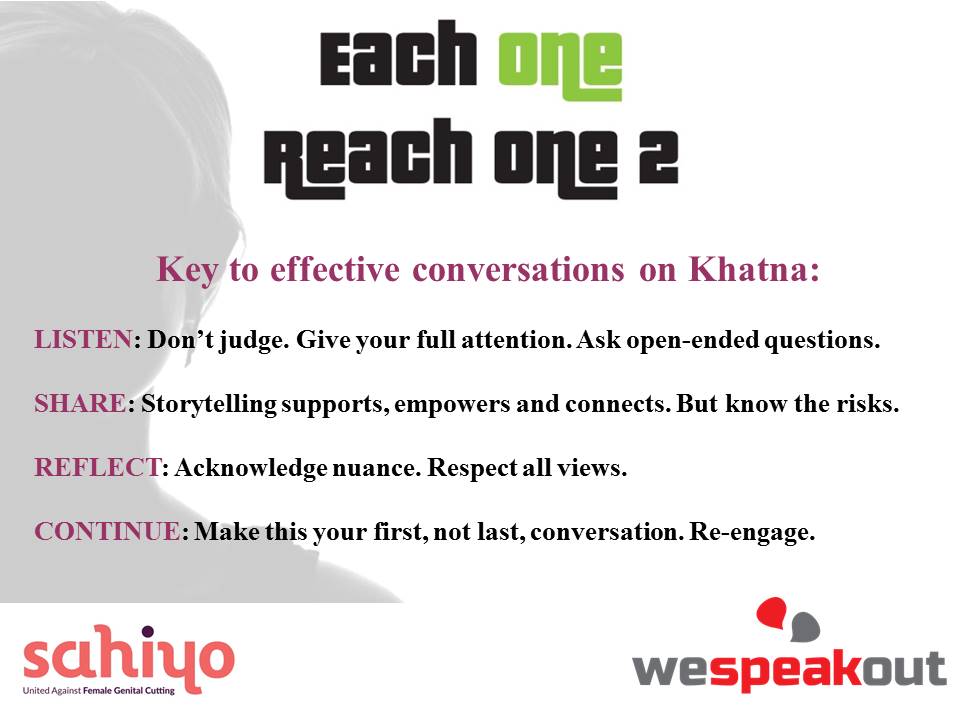By Hina Javed
(This is the second part in a series of essays by Hina Javed on her experience of reporting on FGC in Pakistan. Read the whole series here: Pakistan Journal.)
That night, after witnessing truth being replaced with the censor’s lie, I spent hours alone in my room, flinching at every little thought that crossed my mind. I sat on the tiniest corner of my bed, locked in a deep sulk. In the ensuing minutes and the quiet of that night, thoughts frantically raced through my head in an attempt to find the answer. Was the issue of female genital cutting (FGC) so intimidating that it could not be expressed aloud in the Pakistani media? Was this the way of patriarchy? It made you suffer in silence.
I traced my steps back to where I had deviated from the norm. The more I struggled to solve the mystery of why my well-researched article on FGC in Pakistan was no longer going to be published, the more I was convinced that the questions would be put away in the recesses of my mind, like an unsolved riddle.
In that instant, brief fragments of past conversations bubbled up in my consciousness. How bizarre it was that the reminders came flooding in at the very moment disorder took over my existence. I was now back to square one, having my first conversation with Amber* after she acknowledged the existence of FGC so matter-of-factly.
“But why would you cut an innocent girl who is still tasting the sweetness of childhood?” I asked, trying to make sense of it all.
“There is no harm in it,” Amber spoke with an indifference. “It makes the child pure for the rest of her life. We live in a sinful age where girls deviate when they hit puberty. Khatna is done to preserve their chastity and it’s a good thing!”
I nodded, less in agreement, and more as a courtesy to show I was listening.
“You know how in foreign lands girls explore their sexuality before tying the knot?” She said in an almost condescending tone. “Circumcised girls don’t indulge in such things.”
Amber’s words hit me like a ton of bricks. We had been friends for some time now and frequently discussed women’s rights, consent, and feminism. In every conversation, it surprised me how much the two of us thought alike. However, this time I could not believe my ears as I listened to her justify female genital cutting.
I held myself from lashing out in protest at her promoting FGC. As Amber’s friend, and not a journalist, I could have countered her justifications. But, I refrained from hurting her religious sentiments and gave her the benefit of doubt to see if I was missing a point.
“But doesn’t it hurt a girl’s sexuality as she grows up?” I asked, my face scrunching up into an expression of worry. “What if your daughter doesn’t want this for herself?”
“It doesn’t work like that,” Amber said, softening her tone. “There was a time when family elders used to mask reality and constantly take us by surprise. There was less communication and more innocence. But, when it came to my daughter, I mentally prepared her for it ahead of time.”
I nodded, again less in agreement and more in courtesy.
“The doctor asked me not to hide anything from my daughter. In fact, this doctor is so professional, she doesn’t circumcise girls without their consent.”
“What was your daughter’s reaction like?” I asked in a muffled tone, full of disbelief at what Amber was telling me.
“She was scared and had her fears, but she knew what was coming. After a few conversations, she made peace with it,” Amber went on. “My daughter will never blame me because I took her consent. Mothers who do it without their daughter’s consent are wrong, in my opinion. There is no harm in asking. They are girls. They will understand.”
Listening to Amber made me realize how we, as a society, misunderstand the concept of consent. The definition of ‘consent’ is written in crayon; raw, unfinished, unprocessed. What is confusing to a great many people is that consent cannot be given by a minor who because of their age cannot grasp the full implications of what is happening to them. Consent is more than forcing a grudging “yes” out of someone; it means getting informed permission from a person when they have the reasoning capacities of an adult. This lack of understanding consent can cause a lifelong impact on a girl’s sexuality when they are an adult – one that is eternally painful.
Amber and I gauged each other’s expressions with an uncertainty only we could discern. She was patient with my questions, but now I could feel a thought forming at the edge of her consciousness. She was wondering if perhaps I viewed her differently, thought negatively of her actions. She was starting to get a little frazzled. I changed the topic and asked her if I could call the following day.
That night, I decided to pursue this topic as a story. I perused online resources and posted in a few closed forums to connect with more survivors. The mere thought of doing a thorough investigation on a topic as sensitive as FGC seemed far-fetched – almost impossible. I received several warnings from friends and colleagues asking me to back off. I didn’t.
The next day, I brewed coffee, cleaned my work space, drafted the questions and called Amber. Since my journalistic hat was now on, I decided to remain neutral – barely interrupting her as she spoke.
“Hello!” Amber said after picking up her phone.
“Hi!” I responded.
We waited for each other to fill the silence as if we had yet to discover the language in which we could really communicate on this topic.
“I hope I am not being a bother,” I said after 60 seconds.
“Not at all! Shoot me your questions, but please conceal my identity,” she requested.
“How prevalent is the practice in your community?” I asked as I checkmarked the question in my notebook.
“Well, it’s certainly not decreasing. I would say the trend is static. As hard as it would be for an outsider to believe, it’s still widely practiced by the current generation of Bohras,” she said. “It is a religious compulsion which everyone has to perform. Those who are doing it, continue the trend by passing their beliefs and values down the generations.”
“What do you think about the people who do not practice it?” I asked next.
“There are good and bad people in every community. While I won’t say those who have opted out of it are bad people, they could just be skeptical and unclear about the practice. Either way, it’s their belief and choice,” she said with a heavy heart. “But it is sad that nobody is there to clear the doubts of those who are distrustful of this practice.”
I paused for a brief moment to reflect on what she said and then asked, “How are they supposed to learn the reasoning behind this practice?”
Amber had been waiting for me to ask this question. She wanted me to explain her side of the coin. Perhaps, even promote it.
“Hina, I want to make this concept very clear to the general public. We face so much hostility from people; those who have failed to understand the essence of circumcision. They are the ones who have lost its meaning to time and are trying to garner attention from the rest of the world,” she poured her heart. “Not everyone is able to understand its absolute significance because it’s not easy to digest.”
“Would you like to explain the significance?” I asked.
“There’s a lot of depth to this practice. Even if I explain it to you, you will not understand and definitely won’t be able to do justice breaking it down in your article,” she responded.
“Can I try?” I asked in a faint voice.
“I will first look for an answer myself, and whatever I take from it, I will pass it on to you. It is necessary for me to seek a scholar’s counsel first.”
“Of course!” I said politely. “You can take your time. I would be delighted to write about the flipside too. It’s my job to balance the narrative.”
In that instant, the phone went silent at the other end.
“Hello? Hello?! Amber?” I kept saying, talking only to myself.
A few days later Amber called me back to apologise for the abrupt way our phone call ended. Her mother-in-law had flipped after hearing Amber utter the word Khatna to a stranger on the phone and told her to get off the phone. The overwhelming pressure mounted by her mother-in-law caused Amber to tell me that she would have to end her participation in my investigation. “I’ll try to answer most of your questions today, but I am afraid I will no longer be able to help you with this,” she said, a hint of fear in her tone.
“It’s okay, Amber. The last thing I want you to be is uncomfortable. It’s your choice to go ahead with it or opt out.” I answered.
“Hina, as promised, I reached out to a scholar. He refused to be quoted, so I will answer on his behalf and add a bit of my own knowledge.”
“That’s absolutely fine.” I said, then she shared with me her bit of knowledge.
“I will give you an example which will basically sum up everything. You know how when we read the Holy Book, there are certain words that have no meaning, or perhaps have layers of meanings? Circumcision is like that. There is so much depth to it that we will fail to understand it. A one liner won’t do it justice.”
Once again, her reponse left with me more questions instead of answers. I was now more determined in my quest for clarity. Suddenly, it was no longer about my next exclusive story and I fast realised that the only way to end my curiosity would be to ask more questions. It was now a matter of reaching out to the right people in the hope of getting to the bottom of the ambiguity surrounding khatna.
Time to pick up that phone, Hina, I thought to myself. And just like that, I embarked on my quest to search for answers. Little did I know that the journey ahead was full of obstacles, some of which would stretch me to the point that my existence was bursting at the seams.
*Amber is a pseudonym. The person’s original name has been changed to protect her identity.
To read Part III – A tale of deception: My conversation with an FGC survivor in Pakistan, click here.
(Hina Javed is an investigative journalist based in Pakistan, driven by the ambition of tackling difficult, often untouched topics. Her focus is on stories related to human rights, health and gender.)





